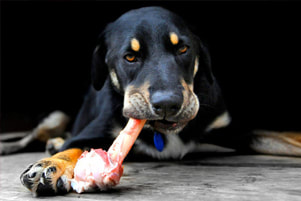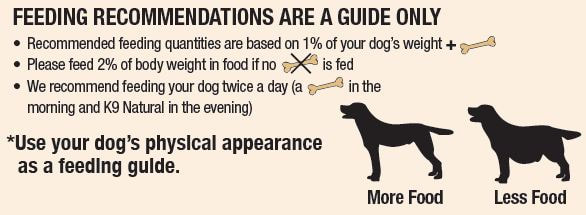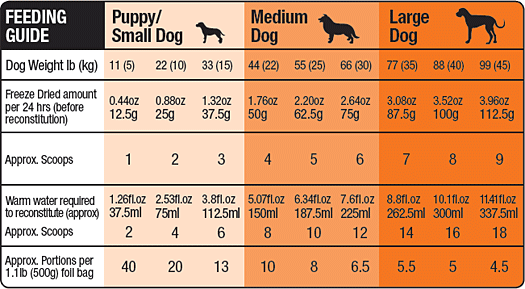The BasicsVary the flavours. All our raw food products are available in different flavour varieties and we recommend you alternate between flavours to provide your dog with the kind of variety it would experience in the wild.
Stop feeding other foods when you introduce your dog or cat to Raw Products. It is perfectly safe to stop feeding your dog’s processed food one day and introduce a Raw Product the next. A gradual introduction (i.e. feeding some of your dog’s previous food as well as some Raw Products), is not recommended, especially if you have previously fed your dog a dry diet. A gradual introduction makes it difficult to gauge the correct amount of food that your dog should have and could cause stomach upsets.
|
Start from the beginning |
|
Kittens should be fed 2% of body weight, three meals a day.
During adulthood, approximately 2% of the dog's or cat's body weight in food should be fed, if no bone is fed daily and 1% if a bone is provided. Puppies should be fed up to 9% of body weight per day in three meals until 12 weeks old. Then gradually reduce until the amount fed is 3% at 12 months old, in one meal.
|
|
The best why to unsure that your puppy or kitten is going to have a long-lived life is to start feeding raw food from the start.
The picture on the right is of 4-week-old puppies starting to enjoy their bony treats throughout the day. It helps you keep them busy, too! |
Handle Raw Products with care |
How Much Should You Feed?Each dog is different and will have their own energy needs. Feeding the right amount is about finding the right balance for your dog. The feeding suggestions below offer a starting point for you to work from. Keep an eye on your dog's weight and adjust the feed amount appropriately.
Ideally, you should be able to see a slight waist when looking along your dog's spine, you should be able to feel their ribs but they should not stick out or be too visible, and there should be a slight stomach tuck viewing from side on.
Recommended Portion GuidesThe recommended amount of Raw Products may be less than you would feed your dog in kibble, dog roll, dehydrated or canned food. The key point to remember is that quality is more important than quantity. The calories and nutritional value that your dog gets from an appropriate portion of Raw Products mimics what nature provides them naturally. Avoid the temptation of feeding more, unless you notice undesirable weight loss.
Remember that these amounts are guides only - start with the recommended portion amount and take into consideration your dog's activity level. Also adjust the amount you feed if you notice weight gain or undesirable weight loss (fat loss, however, is desirable). Wolves tend to eat at dawn and dusk. So we suggest feeding Raw Products plus raw meaty bones at these times. For example, you could feed your dog its recommended amount of Raw Products in the evening and its raw meaty bone in the morning, or vice versa. Our Raw Products are made from inspected and passed meat, poultry and fish. However, any meat product can contain bacteria that could cause illness if mishandled. Please follow these instructions for your protection:
|
Store Raw Food Products appropriately |
|
Our Raw Products are purposely free of artificial preservatives. Our freeze-dried range has a two year shelf life if the bag is not opened. Once opened, please discard within three months. Once reconstituted, please refrigerate and discard within three days. Our frozen range has an 18 month shelf life while it is frozen. Once the product is defrosted please refrigerate and discard within three days.
|
Don’t remove the blood from our Raw Products |
|
Blood is there for a reason. Our Raw Products only contain meat that is derived from animals that have been inspected by NZFSA approved staff. This meat has been drained of blood as part of the normal method of preparation for human consumption. However, because blood is such a desirable part of your dog’s or cat's diet (due to the beneficial vitamins and minerals it contains), we go to some considerable effort to collect and add back the blood from this meat.
|
Obesity |
|
Society has become accustomed to overweight dogs and cats, yet, by nature, dogs and cats are meant to be lean. If they could not catch their prey they would starve to death. You are not doing your dog or cat any favours by over feeding it and you could risk killing it with what you might think is "kindness". Overweight and obese dogs and cats are at risk of many serious health problems such as diabetes, heart disease and respiratory illnesses. Carrying all that extra weight puts enormous pressure on bones and joints. Sadly, obese dogs live shorter lives than healthy, active dogs.
We encourage you to monitor your dog's or cat's weight regularly (both by sight and touch) and to aim to keep it within a healthy range. Your vet can advise you on what that healthy range should be, based on its breed, age, activity level etc. For your pet's sake, be vigilant and if you notice that it has gained or lost weight, adjust the amount you feed accordingly until it returns to a healthy weight. Trust your instincts that you know how much to feed. |



